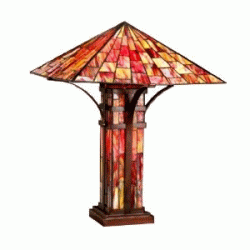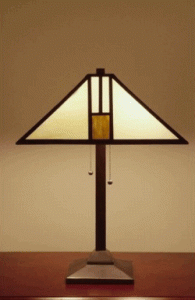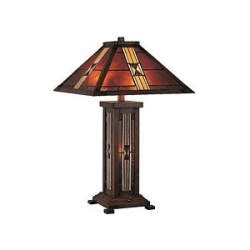Mission-Style Lamps
Mission style lamps are inspired by the Arts and Crafts Movement of the turn of the Twentieth Century.
Mission style lamps arose as a part of an overall interior design movement from the turn of the Twentieth Century. Concerned with the way industrialization had removed the beauty of hand-craftsmanship from interior decoration, the American “Arts and Crafts Movement” sought to restore the detail of handy work to the home, especially the increasingly common middle-class home. Paradoxically, mission lamps look little if anything like actual lamps from the Spanish missions they were claiming to emulate. In fact, most mission lamps would catch fire if they were lit by gas or flame as they have nowhere for the smoke to escape. Instead, mission lamps represent a guess or an ideal of lamp design, trying to restore a combination of hand craftsmanship and simplicity.
Today, most mission lamps are not hand-crafted. Instead, they are inspired by the unique designs produced during the Arts and Crafts Movement. Such lamps usually include geometric, linear shapes and full shades that diffuse all of the light that comes out of the lamp. Hand crafted mission lamps are still produced, but the term currently refers to a particular style of lamp, not a particular type of manufacture.
What Are Mission Style Lamps?
“Mission style lamps” now usually refers to a particular shape of lampshade, which was they type most commonly produced during the Arts and Crafts Movement. The lampshade has a number of flat sides, usually four. These are usually isosceles trapezoids, with the narrow side near the top and the wider end near the bottom. These four (or more) trapezoids are connected together at their edges, and an opaque square connects their narrow ends at the top. (Note that Mission-style outdoor lighting refers to a much wider range of styles).

The usual shape of a mission style lamp is that of an Aztec pyramid.
While this has become the definition of a mission style lamp, a number of elements are very common. First, the shade is almost always translucent. Originally, these shades would have been a very thin wood that would have allowed out only a limited amount of light. However, since their early production, wood has been replaced by fabric or translucent glass. The preference for wood coloring, though, still remains, and most mission lamps are light-brown colored.
Another common feature of mission lamps is that the lamp’s stem will match the geometry of the lamp shade in a number of ways. First, it will generally be carved in a geometric shape that matches the shade. For instance, if the shade has four sides, the lamp post will be a quadrilateral, or at least composed of quadrilaterals. Moreover, the base of the lamp will often reflect the style of the lamp shade. This is more subtle than pure imitation, however. For instance, since mission lamp shades are roughly pyramid shaped, the base will often include pieces of wood or metal stacked in a pyramid fashion.
Light Quality
Beams of Light

Mission style lamps arose in the Arts and Crafts Movement at the turn of the last century. This model is available at Amazon.
Perhaps the most unique feature of mission lamps is that they are closed on top. This is why real missions could never have used this style ,as a closed top would have caused fires! Most lamps have a hole in the top of the lampshade, creating a beam of light going upward. Mission lamps lack this hole, which actually significantly alters the type of light that is produced by the lamp.
Normally, the beam that comes from the top of a lamp will strike the wall, as most lamps are placed near to walls. This has two distinct effects. First, it creates what is called a “light object” on the wall, in this case a conical shape that gets larger further away from the lamp. Some people like these light objects and, indeed, many people choose their lamps based partly on the type of light objects they create. However, if you don’t like these objects, a mission style lamp might be just the right choice.
Second, the lack of a hole on the top prevents much light from escaping upward. Usually the upward escaping light will, at least, provide some light on the wall above the light. On the contrary, mission lamps will produce very little light above them. If no other light sources are used nearby, a mission style lamp will create a dark area above the lamps. In addition, floor lamps are often used to create overall, ambient light by reflecting their beams from the ceiling. Mission lamps simply cannot do this.
Lamp Shades

Mission lamps cast light downwards but do not have the usual upward beam. This model is available at Amazon.
The lamp shades on mission style lamps tend to be thicker than they are on other lamps, which creates some challenges for using them in an overall lighting plan. Because of the thicker shades, the light that escapes through the shade will not be as strong, and it is unlikely you will be able to light a room entirely (or even predominantly) with mission style shades.
The light that a mission lamp shines downward is substantially brighter than the light it shines in any other direction. This can be of benefit when they are used as reading lamps. Normally, the brighter a reading lamp, the more light it shines throughout the room, especially upward. With a mission-style lamp, you can shine a fairly bright beam of light down onto books without greatly increasing overall light levels. This makes mission lamps excellent for home libraries where you want an overall subdued level of light but want sufficient light for reading.
The color of the shades, assuming that the shades are the usual brown color, is actually quite nice for socialization. Brown light brings out the redder tones in people’s skin, making them look healthy. Moreover, because the light that comes through the shades is diffuse, it doesn’t cast harsh shadows. In other words, light that comes through the shades of mission style lamps produces both important conditions for quality skin lighting: reddish light and diffusion.
Decorative Options

Currently, the most common style of mission style lamps is to use a glass, Tiffany-style shade. This style is available at Amazon.
Mission style lamps provide a number of options for decoration. The flat sides provide a perfect location for drawing or stitching intricate decorations that can be repeated symmetrically across the different panels of the shade. Most commonly, the decorations on mission lamps will reflect the overall geometric quality of the lamp shade itself. For example, it will consist of lines, colored shapes and other patterns that repeat and mix with the shade, the stem and the base.
Recently, Tiffany-style mission-style lamps have become popular. The somewhat repetitive name comes from the placing of “Tiffany-style” panes of stained glass onto the geometric panels of mission lamps. This is not a surprising fusion. Stained glass is more easily placed on flat panels than on rounded shades, and both styles prefer colors in the brown range. If you do choose to use such a shade, be aware that stained glass does not diffuse light quite as well as cloth or wood, so try looking at a Tiffany-style lamp with other lights off to see if it hurts your eyes before you purchase it.
Putting It All Together
Mission style lamps originated in the Arts and Crafts Movement at the turn of the Twentieth Century:
- They use geometric, linear patterns and attempt to recapture the feeling of having been hand crafted.
- They do not cast a beam of light upward, which can produce dark areas above them.
- They make excellent reading lights for rooms with subdued lighting.
- They are excellent for lighting human faces.
- They come in a number of decorative options, including stained-glass, Tiffany-style shades.
With all this in mind, you may be able to find just the right spot in your home for a mission style lamp.